Greenland's first product designer triggers "explosion of new designers" in her homeland
DesignMarch 2015: when Greenlander Liss Stender launched her homeware products, she made the national news and created "a kind of shock." She spoke to Dezeen about working in the Arctic and being a design pioneer in a country with a strong craft tradition (+ interview).
Self-taught graphic and product designer Liss Stender set up studio Inuk Design four years ago after noticing a dearth of Greenlandic products on the shelves.
"I think I'm the first product designer [from Greenland]," she told Dezeen during Icelandic festival DesignMarch, where she exhibited items from her debut collection.
Stender designs crockery and fabrics adorned with monochrome graphics depicting the country's national costumes. Produced in runs of up to 200 pieces, her products offer a stark contrast to the one-off hand-carved bone and stone products typically produced by Greenland's craftspeople.
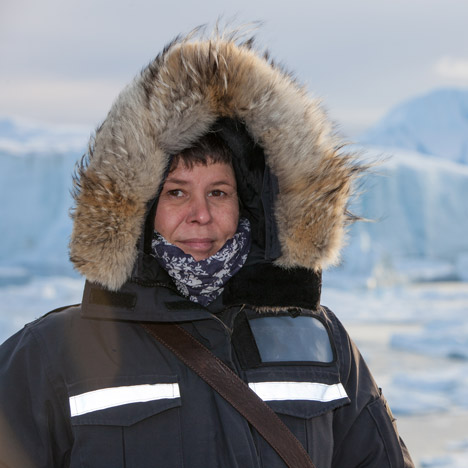
Stender said that despite having its own style of craft, the country had no design tradition. "When I showed this work everyone was in a kind of shock," she said.
"This is a totally new way of working in Greenland because I want to make it for everyday use," she explained. "It's not typically Greenlandic."
The island of Greenland measures over 836,000 square miles but has just 56,000 inhabitants, making it the least densely populated country in the world.
Many Greenlanders work in the fishing and mining industries or have jobs in the public sector, so Stender and her husband Peter Jensen – who co-founded the studio – are rare both for the creative nature of their work and for running their own small business.
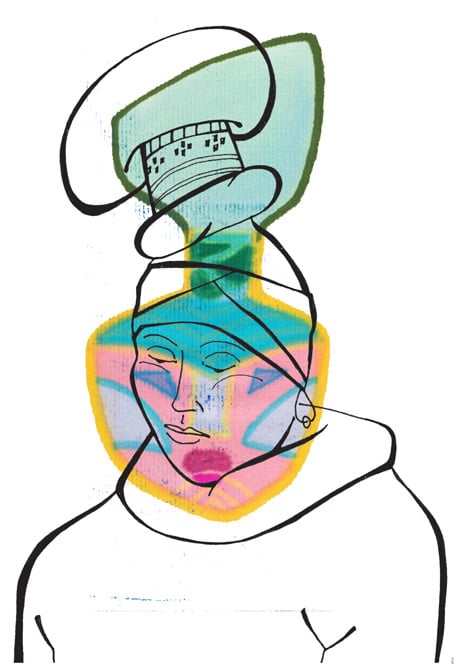
"I'm kind of a pioneer for this modern culture of Greenlandic design," said Stender. "I came up with these [products] about four years ago and we were on the TV in Greenland. After people saw it there was a kind of explosion of new designers from Greenland."
Stender received a national award for her design work just six months after opening the studio. The couple sells the products from a shop in the basement of their house as well as online.
Although her products have been well received in Greenland, Stender said it had been difficult to gain an international reputation and to find a way to create larger product runs.
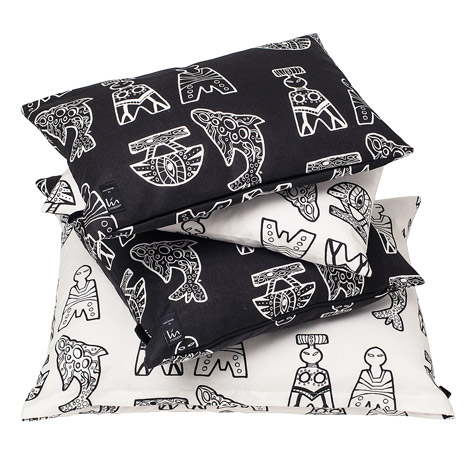
Materials in Greenland are expensive because nearly everything has to be imported, and travel in and out of the country to promote the products abroad is also costly.
"Everything we can buy in the shops comes from Denmark, or from other European countries," explained Jensen. "We have to buy these things and pay in advance before we can get the goods, and after, when we have sold them we can earn money to buy more."
Self-employed Stender hasn't paid herself a salary in over three years but is hopeful that "maybe there is a chance" for the studio's success abroad.
Read the full interview with Liss Stender and Peter Jensen below:
Jessica Mairs: What's the inspiration behind your work?
Liss Stender: I'm an artist and he's a film maker in Greenland. I'm drawing the culture of my land.
Peter Jensen: On the plates you can see the old Icelandic way for women to put their hair up.
Liss Stender: The dolls were first made in wood about 1,000 years ago in north and east Greenland as amulets or small dolls for kids. So I just told the story in my way – very graphic because I'm a graphic designer. This is a 1,000-year-old story.
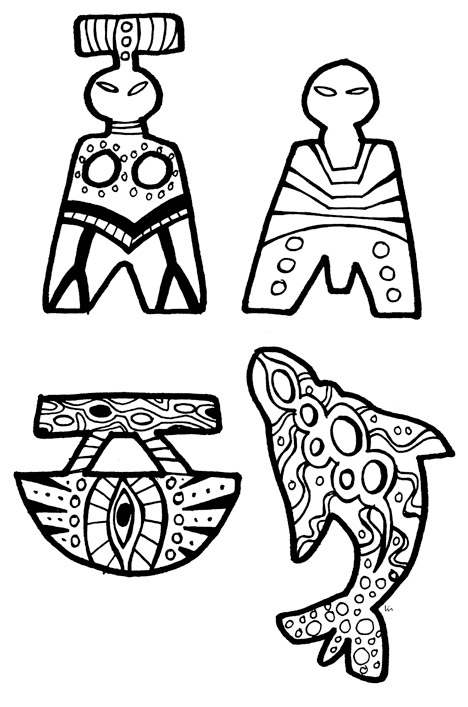
Jessica Mairs: What's it like being a designer in Greenland?
Liss Stender: I think I'm the first product designer. [Greenlandic craftspeople] are using the old way to make hand-crafted bone and stone – very old fashioned.
So when I came up with these [products] about four years ago we were on the TV in Greenland. After people saw it there was a kind of explosion of new designers from Greenland. I'm kind of a pioneer for this modern culture of Greenlandic design.
Jessica Mairs: Is it difficult to get your designs seen internationally being based in such a remote area?
Peter Jensen: It's very difficult. We have some thoughts to move to Reykjavík because it's very expensive to travel in and out of Greenland. Everything is very expensive. There are only 56,000 people on the island and the capital only has 16,000 people.
Liss Stender: But people really like the designs, and many people want them because it tells the true story of our culture.
Jessica Mairs: What is that story?
Liss Stender: This [graphic printed plate collection] is The Five Elements and it represent the four poles in Greenland – north, south, west and east – and the fifth element is us human beings.
Peter Jensen: It represents our national costumes in every area.
Liss Stender: We still use our national costume with big pride. We live very differently from north, west, south to east, really different, so that's what I'm trying to tell. People are really happy about this because it's never been shown like this below.
Jessica Mairs: Does Greenland have any design traditions?
Liss Stender: No, there's nothing at all.
[Points to the jewellery she's wearing] My earrings are carved from narwhale bone and my ring. It's so typically Greenlandic.
This is what they do, so when I showed this work everyone was in a kind of shock. This is totally different. But people could see it and I think we have a great success in Greenland.
Peter Jensen: We just had a meeting in Paris and the shop owner has decided today to have our products in his shop in the middle of Paris and on his website to test it. He really likes the design – the French and Spanish really love Greenland so maybe there is a chance for us.
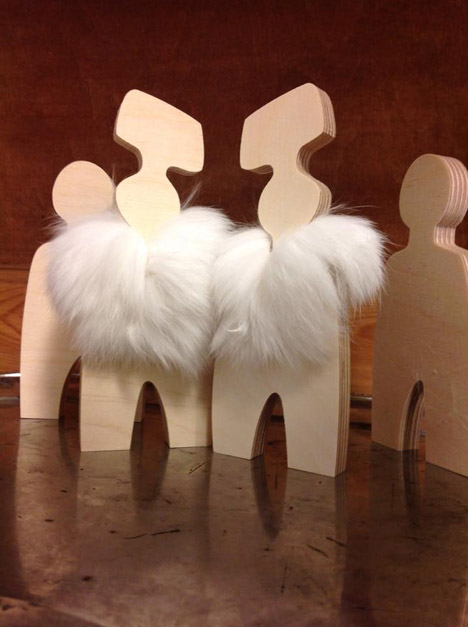
Jessica Mairs: How did they find your work?
Liss Stender: We found them to produce our things. Believe me it has been hard, hard work to find places where they can make very small amounts.
We only produce 200 of each, and that is a really small amount. It's a huge challenge to find people who can make very small runs.
Jessica Mairs: What's your background, did you go to design school?
Liss Stender: We don't have any education – but of course we've been to high school.
Peter Jensen: I dropped my education to be an electrician. In 1978 I started in the local TV station – it was very new at that point. They taped the Danish TV shows and we saw it once a week, for about an hour. Today of course we have internet and everything.
Liss Stender: The development has been really fast. The hunting culture still exists in Greenland. We have an iPhone, but people still hunt, with their iPhone or iPad.
Peter Jensen: Sixty years ago the modernisation of Greenland begun. In 1953 Greenland became part of Denmark. We are new people. We were a hunter culture just sixty years ago.
Liss Stender: Just sixty years ago we were nothing.
Jessica Mairs: Does your work represent those changes in any way?
Liss Stender: This is a totally new way of working in Greenland because I want to make it for everyday use. You can take it home with you and use it. It's not typically Greenlandic.
Many people say its indigenous and it can be from the indians in the Amazon or the inuits in Canada. People relate to this, they can see something indigenous in it and that's also what I'm trying to tell.
Jessica Mairs: How are your products made?
Liss Stender: We are aiming for quality really. We don't produce anything in China for example because we want to support our European countries because they are suffering from the economic crisis. We want to support each other.
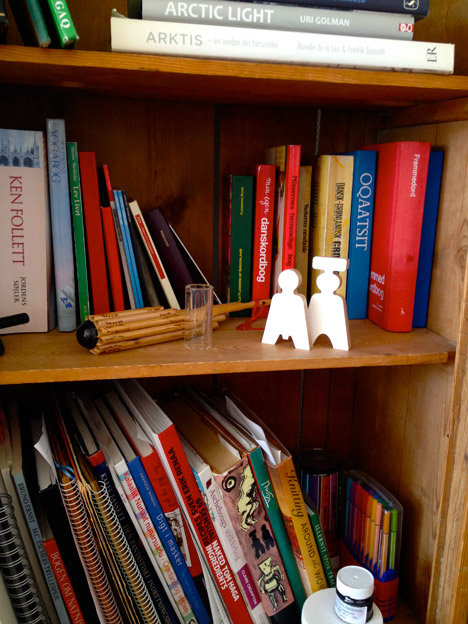
Jessica Mairs: Is it important for you to produce on a small scale, or is this from necessity?
Peter Jensen: We are a really small company, we are just us two. We are not millionaires – we have to buy these things and pay in advance before we can get the goods, and after, when we have sold them we can earn money to buy more.
Liss Stender: I didn't get salary for three years.
Jessica Mairs: Are you being paid now?
Liss Stender: No. We are actually very poor. We are husband and wife and co-workers. I am also a graphic designer for him and we also make big campaigns in Greenland.
Jessica Mairs: How do you balance the contrast of working on commercial and small-scale projects?
Liss Stender: We work 24 hours a day, seven days a week. I'm drawing all the time, I'm working for [Peter] and I'm taking care of the kids. I think I have ADHD. You know, this hyperactivity.
We use every hour of the day and I think it's a lifestyle to be like this. Either you like it or you don't, and we like it because we want to tell a story and we want to tell about Greenland in a modern way.
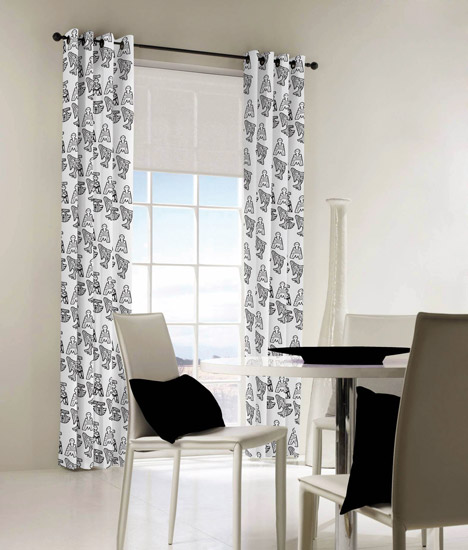
Peter Jensen: We have a house where we have our own little shop in the basement. We are the few entrepreneurs in Greenland. In Greenland, it is very socialistic way of living where everything is owned by the government.
We don't want to work in the government offices or something like that so we're self-employed and it's very difficult.
Jessica Mairs: What kind of response have you had to your business in Greenland?
Liss Stender: I won an award for the best innovative design in our community and [Inuk Design] was only six months old when I got the award.
Peter Jensen: Everything we can buy in the shops comes from Denmark, or from other European countries. When [the public] for the first time saw Greenlandic products they said "wow".
Liss Stender: I was totally overwhelmed.